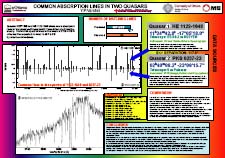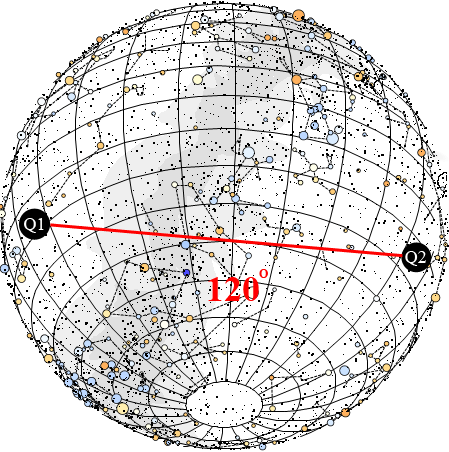| Available in the following formats |  | |
|---|---|---|
| Format | Size | |
| 42 kB (8.5 x 11 inches) 5 pages | ||
| TeX source | 10 kB | |
| Poster | 197 kB (1.12 x 0.91 meter) | |
| Summary | 3 kB (4 paragraphs) | |
Y.P. Varshni
Department of Physics, University of Ottawa, Ottawa, Canada, K1N 6N5
Accepted in 1st Crisis in Cosmology Conference, Portugal, June 23, 2005.
| Abstract: We have found that in the absorption-line spectra of two quasars, 0237-233 and HE 1122-1648 there are a large number of common lines in the observed frame (earth frame). The number of common lines in the interval 3716-4116 Å is 64 while the expected number from the chance- coincidence theory is only 49.7 ± 3.8. An explanation is given. |
| Available in the following formats |  | |
|---|---|---|
| Format | Size | |
| 42 kB (8.5 x 11 inches) 5 pages | ||
| TeX source | 10 kB | |
| Poster | 197 kB (1.12 x 0.91 meter) | |
| Summary | 3 kB (4 paragraphs) | |
The object PKS 0237-23 was identified as a quasar by Arp et al. (1967). There have been a number of investigations on the absorption-line spectrum of 0237-233 (z=2.22). We summarize these investigations here. Early observations were by Arp et al. (1967) (33 absorption lines), Burbidge (1967) (20 lines), Greenstein and Schmidt (1967) (40 lines), Bahcall, Greenstein and Sargent (1968) (49 lines) and by Burbidge et al. (1968) (92 lines).
Boksenberg and Sargent (1975) used the University College London image photon counting system (IPCS) at the Coude focus of the Palomar telescope to obtain the spectrum of 0237-233 at a resolution of 0.71 Å. They give a list of 75 absorption lines in the wavelength range 3737-4270 Å. Boroson et al. (1978, hereafter BSBC) carried out further observations on 0237-233 with the IPCS and these observations were combined with the older data of Boksenberg and Sargent (1975). These authors tabulated wavelengths and equivalent widths of 193 absorption lines in the spectral range 3716-4289 Å.
Other observations are due to Sargent et al. (1988), Petitjean and Bergeron (1994) and by Aldcroft et al. (1994).
Rollinde et al. (2001) have obtained a high resolution and high S/N ratio spectrum of the quasar HE 1122-1628 (z=2.40) during Science Verification of the Ultra-violet and Visible Echelle Spectrograph at the European Southern Observatory on the 8.2 m KUEYEN telescope operated on Cerro Paranal, Chile. They list 187 absorption lines in the wavelength interval 3679-4116 Å.
For 0237-233, for the interval 3679-4116 Å the best available data appears to be that of BSBC. The common wavelength interval is however 3716-4116 Å. In this interval there are 140 lines in 0237-233 and 175 lines in 1122-1628. A comparison of the Rollinde et al. data with the BSBC data shows that if we allow the maximum difference between the two wavelengths, δ λ = 0.5 Å, there are 64 common lines. These lines are shown in Table 1.
Obviously the question arises of chance coincidences. Russell and Bowen (1929) did pioneer work on this question. Using their formulae, we find that the expected number of chance coincidences in our case is 49.7, and the probable error is 3.8. This clearly shows that these coincidences between the wavelength of lines are not chance coincidences, but have a physical reason.
These coincidences can be readily understood on the basis of a theory of quasars proposed by us (Varshni, 1975, 1977, 1978, 1979, 1985, 1988, 1989, Varshni and Lam, 1976, Varshni and Nasser, 1986), which is based on sound physical principles, and does not need the assumption of redshifts. It provides satisfactory explanations of the various phenomena associated with quasars. In short, quasars are a special type of star in which laser action is responsible for the strength of the broad emission lines. This theory is known as the plasma-laser star model of quasars (PLAST). Most of the observational evidence on quasars either supports our theory or else is consistent with it.
If we consider two stars which belong to the same spectral class or to very neighbouring spectral classes, for example two A2 type stars or one A2 type star and the other A3 type star, then they have very many common absorption lines. This arises because in the two cases the plasma where the absorption is occurring is very similar in the two cases. In our theory of quasars the absorption is occurring in the extended atmosphere of a star, much like a shell star. The coincidences between the wavelength of lines in 1122-1648 and 0237-233 is occurring because the shells of these two stars are quite similar.
Here it should be remembered that the observations on 1122-1648 and 0237-233 were carried out by different techniques. As noted by BSBC, some of the lines in their list are actually blends. It was found that some of the lines of 0237-233 have two lines of 1122-1628 within ± 0.5 Å; we have listed only one of the lines which was the nearest. It suggests that a higher resolution spectrum of 0237-233 would likely show greater number of coincidences with 1122-1648 lines. The resolution obtained by BSBC was only 0.7 Å (corresponds to 52 km/s). Now it is possible to obtain much better resolution in quasar spectra. If 0237-233 is studied with a resolution of 10 km/s, the accuracy would be much better and we expect the number density of lines to increase substantially. Such a data would provide a more accurate comparison with 1122-1648.
| 01122-1648 Q1 | Int. | 0237-233 Q2 | EW | Difference |
|---|---|---|---|---|
| 3717.40 | 0.96 | 3716.9 | 0.6 | -0.50 |
| 3723.25 | 2.03 | 3722.8 | 0.9 | -0.45 |
| 3739.34 | 0.32 | 3739.4 | 0.6 | 0.06 |
| 3743.55 | 2.35 | 3743.3 | 0.5 | -0.25 |
| 3747.70 | 0.46 | 3747.4 | 1.1 | -0.30 |
| 3748.41 | 0.74 | 3748.8 | 0.2 | 0.39 |
| 3750.54 | 0.86 | 3750.3 | 0.2 | -0.24 |
| 3758.09 | 0.24 | 3758.3 | 0.2 | 0.21 |
| 3761.46 | 0.40 | 3761.1 | 0.3 | -0.36 |
| 3773.00 | 1.00 | 3773.3 | 0.5 | 0.30 |
| 3787.63 | 0.51 | 3788.0 | 0.5 | 0.37 |
| 3792.35 | 0.07 | 3792.3 | 0.5 | -0.05 |
| 3805.04 | 0.37 | 3804.7 | 0.5 | -0.34 |
| 3806.99 | 0.50 | 3807.4 | 0.1 | 0.41 |
| 3812.38 | 0.11 | 3811.9 | 0.1 | -0.48 |
| 3821.67 | 2.12 | 3821.7 | 0.1 | 0.03 |
| 3827.39 | 0.06 | 3826.9 | 0.1 | -0.49 |
| 3838.65 | 0.19 | 3838.5 | 1.2 | -0.15 |
| 3840.16 | 2.27 | 3840.0 | 0.5 | -0.16 |
| 3844.73 | 0.29 | 3845.2 | 0.1 | 0.47 |
| 3853.99 | 0.44 | 3854.4 | 0.3 | 0.41 |
| 3863.06 | 0.87 | 3862.6 | 0.8 | -0.46 |
| 3869.43 | 0.21 | 3869.7 | 0.2 | 0.27 |
| 3876.69 | 0.29 | 3876.8 | 0.1 | 0.11 |
| 3878.98 | 0.02 | 3879.1 | 0.2 | 0.12 |
| 3882.02 | 0.04 | 3882.0 | 0.1 | -0.02 |
| 3884.70 | 2.43 | 3884.3 | 0.2 | -0.40 |
| 3886.98 | 0.18 | 3886.7 | 1.9 | -0.28 |
| 3894.37 | 0.77 | 3894.1 | 0.4 | -0.27 |
| 3900.96 | 0.26 | 3900.7 | 0.3 | -0.26 |
| 3911.00 | 0.25 | 3910.8 | 0.2 | -0.20 |
| 3924.47 | 0.05 | 3924.6 | 0.3 | 0.13 |
| 3925.10 | 0.09 | 3925.4 | 0.1 | 0.30 |
| 3930.86 | 0.17 | 3930.8 | 0.1 | -0.06 |
| 3937.15 | 0.18 | 3937.2 | 0.1 | 0.05 |
| 3949.37 | 0.20 | 3949.5 | 0.7 | 0.13 |
| 3954.62 | 0.10 | 3954.9 | 0.1 | 0.28 |
| 3955.87 | 0.06 | 3955.7 | 0.1 | -0.17 |
| 3956.62 | 0.17 | 3957.0 | 0.1 | 0.38 |
| 3959.42 | 0.08 | 3959.7 | 0.1 | 0.28 |
| 3963.54 | 2.29 | 3963.7 | 0.2 | 0.16 |
| 3979.04 | 0.24 | 3978.9 | 0.1 | -0.14 |
| 3980.87 | 0.81 | 3981.3 | 0.1 | 0.43 |
| 3984.71 | 1.42 | 3984.7 | 0.1 | -0.01 |
| 3987.04 | 0.35 | 3987.3 | 0.1 | 0.26 |
| 3988.91 | 2.33 | 3989.4 | 0.1 | 0.49 |
| 4010.39 | 0.57 | 4009.9 | 0.2 | -0.49 |
| 4024.83 | 0.36 | 4025.1 | 1.2 | 0.27 |
| 4028.67 | 0.41 | 4029.0 | 0.1 | 0.33 |
| 4037.33 | 0.24 | 4037.6 | 0.1 | 0.27 |
| 4038.80 | 1.33 | 4038.4 | 0.1 | -0.40 |
| 4041.29 | 2.17 | 4041.0 | 0.6 | -0.29 |
| 4055.14 | 0.22 | 4054.8 | 0.1 | -0.34 |
| 4056.06 | 0.23 | 4056.1 | 0.3 | 0.04 |
| 4057.36 | 0.30 | 4057.6 | 0.1 | 0.24 |
| 4063.35 | 0.21 | 4063.8 | 0.4 | 0.45 |
| 4078.79 | 1.61 | 4078.6 | 1.1 | -0.19 |
| 4080.30 | 0.46 | 4080.4 | 0.3 | 0.10 |
| 4087.01 | 1.00 | 4087.2 | 0.2 | 0.19 |
| 4094.34 | 4.02 | 4094.5 | 0.1 | 0.16 |
| 4096.01 | 0.28 | 4095.7 | 0.2 | -0.31 |
| 4098.14 | 0.06 | 4098.5 | 0.1 | 0.36 |
| 4100.79 | 0.02 | 4100.7 | 0.1 | -0.09 |
| 4115.24 | 0.10 | 4115.2 | 0.4 | -0.04 |
| * All wavelengths are in Å and are for air. | ||||
